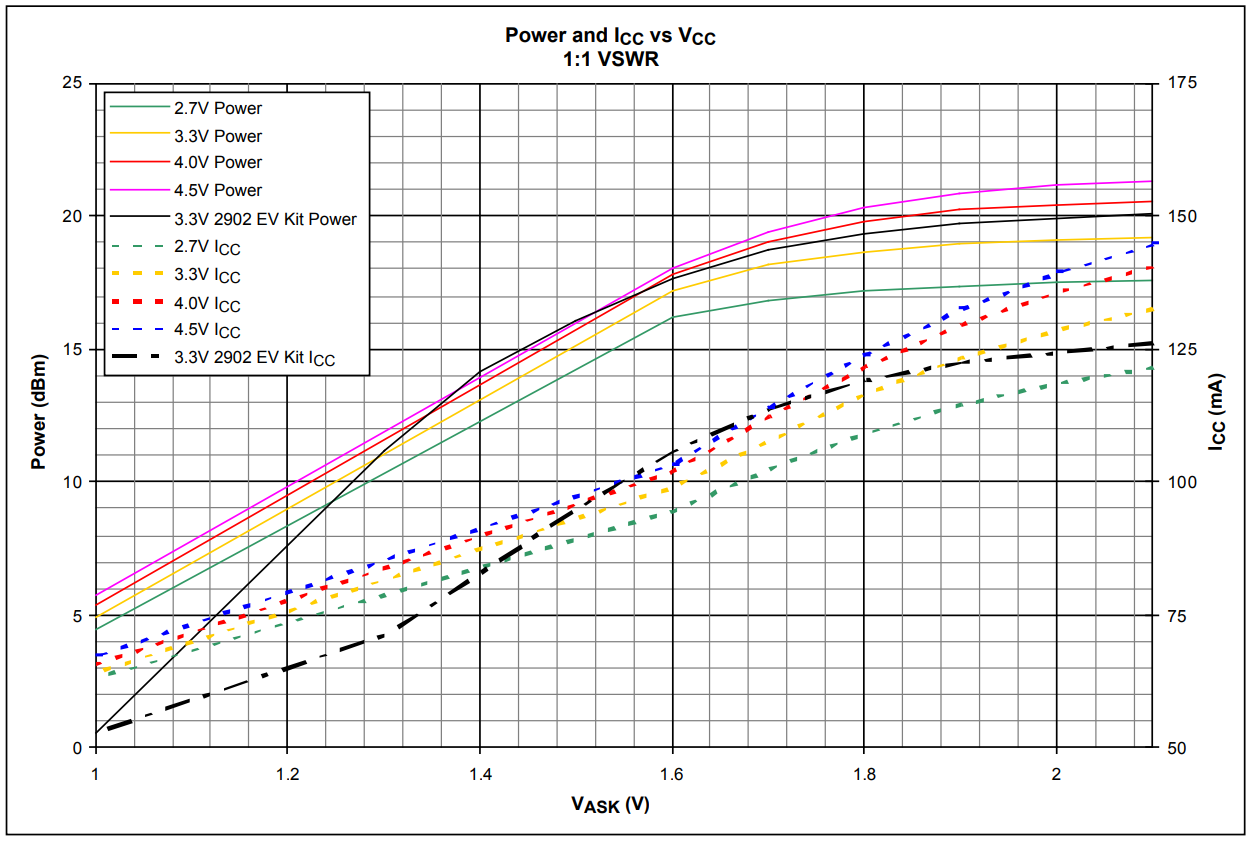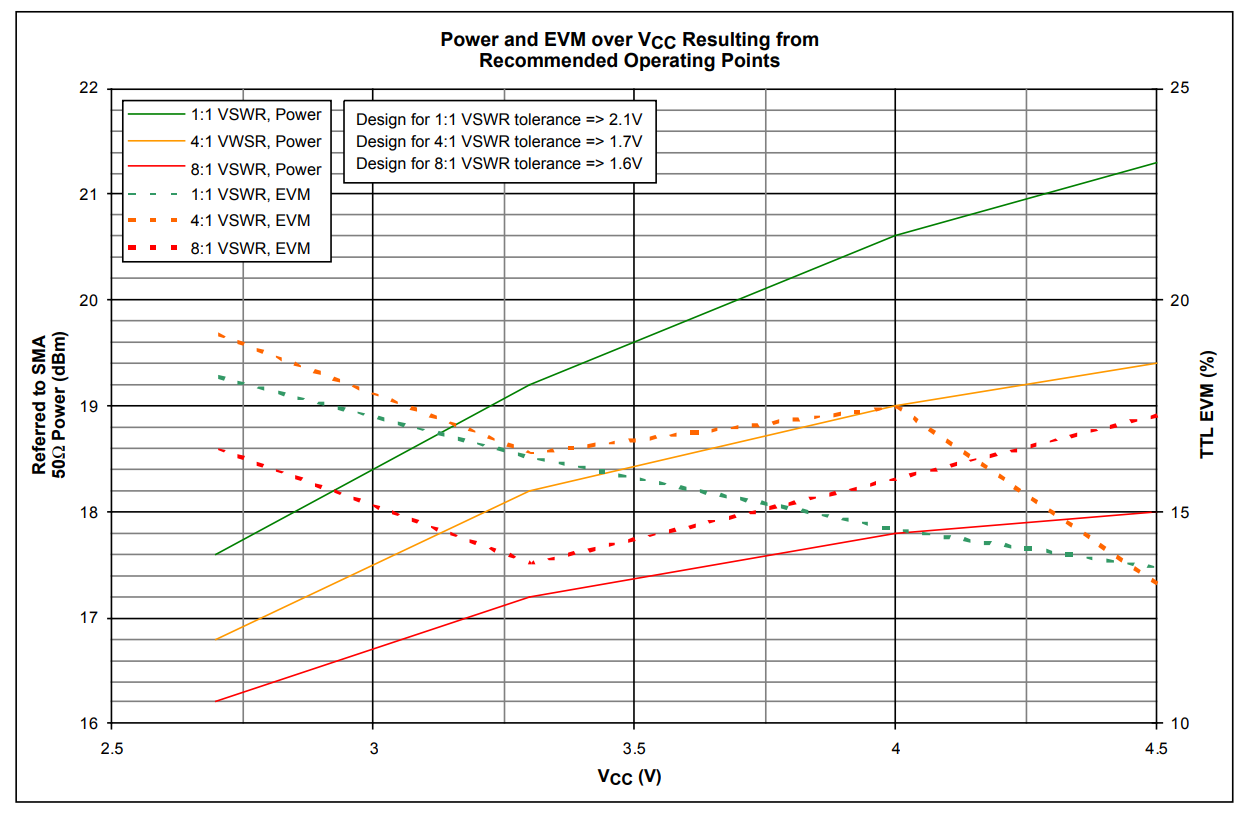

Lab Measurements
System Performance Summary
Measured at ANT RF SMA; VCC = 3.3V; TA = +25°C; REF-OSC Freq = 40MHz; PLL locked at 900MHz; LDOEN = high; CSB = high; SCLK = DIN = Low; 2.5VP-P 1.0Mbps PN bit stream (unfiltered) applied to BPSK input, unless otherwise noted.
| Parameter | Conditions and Comments | Target | Measured | Units | ||
| >Supply Current | Shutdown mode (LDOEN = LOW), VCC = 4.5V (worst case) | 1.7 | µA | |||
| For +17.5dBm at LPF output (VASK = 2.1) Includes LMX2353 synthesizer and TCXO supply current. |
141 | 104 | mA | |||
| Tuning Range | Range of VCO, freq determined by PLL | 902 to 928 | 902 to 928 | MHz | ||
| LO Integrated Phase Error | In 2MHz BW of demodulator, no modulation | 1.6 | °RMS | |||
| Phase EVM | EVM contribution from the above RMS phase error (for small angles, approximate EVM by ΦERR/(360/2pi) |
2.8 | % | |||
| Magnitude EVM | No modulation | 0.2 | % | |||
| 1.0Mbps PN sequence BPSK modulation | 13 to 14 | % | ||||
| Full-Power EVM | VASK = 2.1V, 8:1 VSWR (worst-case angle) Dominated by distortion due to VCO pulling |
VCC_MAIN = 2.7V, ICC = 106mA (50Ω pwr = +16.9dBm) | 20 | 40.2 | % | |
| VCC_MAIN = 3.3V, ICC = 114mA (50Ω pwr = +19.2dBm) | 20 | 43.6 | ||||
| VCC_MAIN = 4.0V, ICC = 138mA (50Ω pwr = +20.6dBm) | 20 | 53.3 | ||||
| VCC_MAIN = 4.5V, ICC = 299mA (50Ω pwr = +21.3dBm) | 20 | 30.1 | ||||
| Output Power | 50Ω load, 1.0Mbps BPSK modulation (Power at balun output is approx 1dB higher, due to BPF, T-line, SMA) EVM for specified VSWR (worst-case phase angle) is less than 20% |
VASK = 2.1V (for 1:1 VSWR tolerance) |
VCC_MAIN = 2.7V, ICC = 103mA | 16.9 | dBm | |
| VCC_MAIN = 3.3V, ICC = 133mA | 17.5 | 19.2 | ||||
| VCC_MAIN = 4.0V, ICC = 141mA | 20.6 | |||||
| VCC_MAIN = 4.5V, ICC = 145mA | 21.3 | |||||
| VASK = 1.7V (for 4:1 VSWR tolerance) |
VCC_MAIN = 2.7V, ICC = 103mA | 16.7 | ||||
| VCC_MAIN = 3.3V, ICC = 108mA | 18.2 | |||||
| VCC_MAIN = 4.0V, ICC = 112mA | 19.0 | |||||
| VCC_MAIN = 4.5V, ICC = 114mA | 19.4 | |||||
| VASK = 1.6V (for 8:1 VSWR tolerance) |
VCC_MAIN = 2.7V, ICC = 95mA | 16.2 | ||||
| VCC_MAIN = 3.3V, ICC = 99mA | 17.2 | |||||
| VCC_MAIN = 4.0V, ICC = 102mA | 17.8 | |||||
| VCC_MAIN = 4.5V, ICC = 104mA | 18.1 | |||||
| Reference Spurs | fCOMP = 2MHz, worst-case condition: VCC = 4.5V, +21.3dBm output power Actual measurement was < -63dBc (below noise floor of VSA) |
< -41 | < -42 | dBm/MHz | ||
| Output Harmonics | 2nd harmonic levels, at LPF output (limit is -27dBm/MHz in nonrestricted bands) | < -30 | -42 | dBm/MHz | ||
| 3rd harmonic levels, at LPF output (limit is -41dBm/MHz in restricted bands) | < -49 | -54 | ||||
Measurement Data



Design for 1:1 VSWR tolerance ≥ 2.1V
Design for 4:1 VSWR tolerance ≥ 1.7V
Design for 8:1 VSWR tolerance ≥ 1.6V
Detailed Description
The MAX2902 is single-chip transmitter designed for use in 868MHz to 915MHz frequency bands. It complies with FCC CFR47 part 15.247 902MHz to 928MHz ISM band specifications.
The transmitter IC offers a high level of integration while minimizing external components. The transmit modulator, power amplifier, RF VCO, 8-channel frequency synthesizer, and baseband PN sequence lowpass filter are all integrated. By filtering BPSK modulation, the spurious emissions are reduced, enabling up to 8 independent transmit channels in the U.S. ISM band. Inputs are provided for spread-spectrum BPSK, ASK, and OOK. FM can be achieved by directly modulating the VCO. The device is intended primarily for use with external differential antenna.
In this reference design the MAX2902 is applied as the transmit IC in the 900MHz band. It is controlled by a National Semiconductor LMX2353 fractional-N PLL.




















